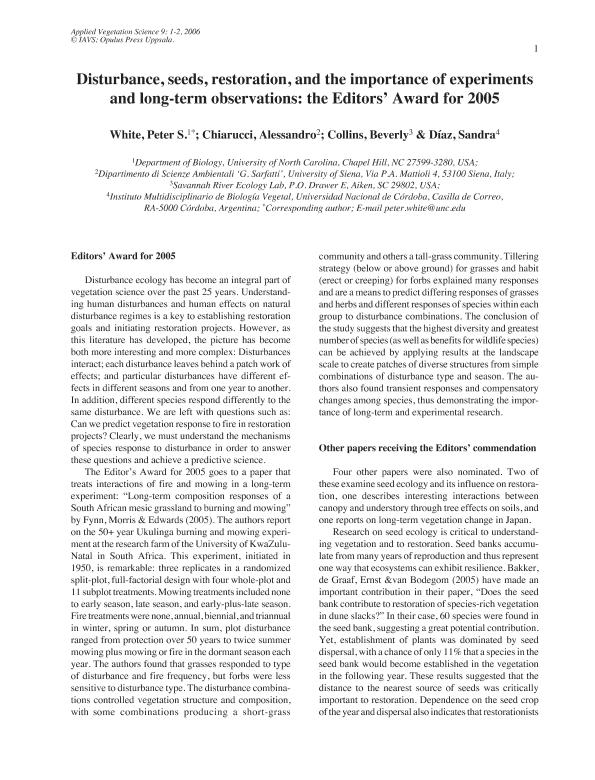Mostrar el registro sencillo del ítem
dc.contributor.author
White, Peter S.
dc.contributor.author
Chiarucci, Alessandro
dc.contributor.author
Collins, Beverly
dc.contributor.author
Díaz, Sandra Myrna

dc.date.available
2018-01-10T17:38:07Z
dc.date.issued
2006-05
dc.identifier.citation
Collins, Beverly; Díaz, Sandra Myrna; Chiarucci, Alessandro; White, Peter S.; Editorial article: Disturbance, seeds, restoration, and the importance of experiments and long-term observations: the Editors’ Award for 2005; Wiley Blackwell Publishing, Inc; Applied Vegetation Science; 9; 1; 5-2006; 1-2
dc.identifier.issn
1402-2001
dc.identifier.uri
http://hdl.handle.net/11336/32823
dc.description.abstract
Disturbance ecology has become an integral part of vegetation science over the past 25 years. Understanding human disturbances and human effects on natural disturbance regimes is a key to establishing restoration goals and initiating restoration projects. However, as this literature has developed, the picture has become both more interesting and more complex: Disturbances interact; each disturbance leaves behind a patch work of effects; and particular disturbances have different effects in different seasons and from one year to another. In addition, different species respond differently to the same disturbance. We are left with questions such as: Can we predict vegetation response to fire in restoration projects? Clearly, we must understand the mechanisms of species response to disturbance in order to answer these questions and achieve a predictive science. The Editor’s Award for 2005 goes to a paper that treats interactions of fire and mowing in a long-term experiment: “Long-term composition responses of a South African mesic grassland to burning and mowing” by Fynn, Morris & Edwards (2005). The authors report on the 50+ year Ukulinga burning and mowing experiment at the research farm of the University of KwaZuluNatal in South Africa. This experiment, initiated in 1950, is remarkable: three replicates in a randomized split-plot, full-factorial design with four whole-plot and 11 subplot treatments. Mowing treatments included none to early season, late season, and early-plus-late season. Fire treatments were none, annual, biennial, and triannual in winter, spring or autumn. In sum, plot disturbance ranged from protection over 50 years to twice summer mowing plus mowing or fire in the dormant season each year. The authors found that grasses responded to type of disturbance and fire frequency, but forbs were less sensitive to disturbance type. The disturbance combinations controlled vegetation structure and composition, with some combinations producing a short-grass Disturbance, seeds, restoration, and the importance of experiments and long-term observations: the Editors’ Award for 2005 White, Peter S.1*; Chiarucci, Alessandro2; Collins, Beverly3 & Díaz, Sandra4 1Department of Biology, University of North Carolina, Chapel Hill, NC 27599-3280, USA; 2Dipartimento di Scienze Ambientali ‘G. Sarfatti’, University of Siena, Via P.A. Mattioli 4, 53100 Siena, Italy; 3Savannah River Ecology Lab, P.O. Drawer E, Aiken, SC 29802, USA; 4Instituto Multidisciplinario de Biología Vegetal, Universidad Nacional de Córdoba, Casilla de Correo, RA-5000 Córdoba, Argentina; *Corresponding author; E-mail peter.white@unc.edu community and others a tall-grass community. Tillering strategy (below or above ground) for grasses and habit (erect or creeping) for forbs explained many responses and are a means to predict differing responses of grasses and herbs and different responses of species within each group to disturbance combinations. The conclusion of the study suggests that the highest diversity and greatest number of species (as well as benefits for wildlife species) can be achieved by applying results at the landscape scale to create patches of diverse structures from simple combinations of disturbance type and season. The authors also found transient responses and compensatory changes among species, thus demonstrating the importance of long-term and experimental research.
dc.format
application/pdf
dc.language.iso
eng
dc.publisher
Wiley Blackwell Publishing, Inc

dc.rights
info:eu-repo/semantics/openAccess
dc.rights.uri
https://creativecommons.org/licenses/by-nc-sa/2.5/ar/
dc.subject
Disturbance
dc.subject
Vegetation Science
dc.subject.classification
Otras Ciencias Biológicas

dc.subject.classification
Ciencias Biológicas

dc.subject.classification
CIENCIAS NATURALES Y EXACTAS

dc.title
Editorial article: Disturbance, seeds, restoration, and the importance of experiments and long-term observations: the Editors’ Award for 2005
dc.type
info:eu-repo/semantics/article
dc.type
info:ar-repo/semantics/artículo
dc.type
info:eu-repo/semantics/publishedVersion
dc.date.updated
2017-11-16T15:17:04Z
dc.identifier.eissn
1654-109X
dc.journal.volume
9
dc.journal.number
1
dc.journal.pagination
1-2
dc.journal.pais
Reino Unido

dc.journal.ciudad
Londres
dc.description.fil
Fil: White, Peter S.. University of North Carolina; Estados Unidos
dc.description.fil
Fil: Chiarucci, Alessandro. Universita Degli Studi Di Siena; Italia
dc.description.fil
Fil: Collins, Beverly. University of Georgia. Savannah River Ecology Laboratory; Estados Unidos
dc.description.fil
Fil: Díaz, Sandra Myrna. Consejo Nacional de Investigaciones Científicas y Técnicas. Centro Científico Tecnológico Conicet - Córdoba. Instituto Multidisciplinario de Biología Vegetal. Universidad Nacional de Córdoba. Facultad de Ciencias Exactas Físicas y Naturales. Instituto Multidisciplinario de Biología Vegetal; Argentina
dc.journal.title
Applied Vegetation Science

dc.relation.alternativeid
info:eu-repo/semantics/altIdentifier/url/http://onlinelibrary.wiley.com/doi/10.1111/j.1654-109X.2006.tb00647.x/abstract
dc.relation.alternativeid
info:eu-repo/semantics/altIdentifier/doi/http://dx.doi.org/10.1111/j.1654-109X.2006.tb00647.x
Archivos asociados
